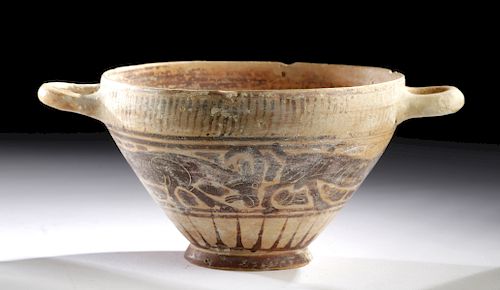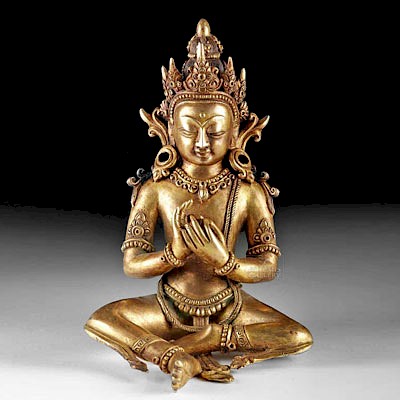Corinthian Ceramic Skyphos with Ibexes
Lot 10c
About Seller
Artemis Fine Arts
686 S Taylor Ave, Ste 106
Louisville, CO 80027
United States
Selling antiquities, ancient and ethnographic art online since 1993, Artemis Gallery specializes in Classical Antiquities (Egyptian, Greek, Roman, Near Eastern), Asian, Pre-Columbian, African / Tribal / Oceanographic art. Our extensive inventory includes pottery, stone, metal, wood, glass and textil...Read more
Estimate:
$1,200 - $1,800
Absentee vs Live bid
Two ways to bid:
- Leave a max absentee bid and the platform will bid on your behalf up to your maximum bid during the live auction.
- Bid live during the auction and your bids will be submitted real-time to the auctioneer.
Bid Increments
| Price | Bid Increment |
|---|---|
| $0 | $25 |
| $300 | $50 |
| $1,000 | $100 |
| $2,000 | $250 |
| $5,000 | $500 |
| $10,000 | $1,000 |
| $20,000 | $2,500 |
| $50,000 | $5,000 |
| $100,000 | $10,000 |
| $200,000 | $20,000 |
About Auction
By Artemis Fine Arts
Jun 6, 2019
Set Reminder
2019-06-06 10:00:00
2019-06-06 10:00:00
America/New_York
Bidsquare
Bidsquare : VARIETY AUCTION | Ancient & Ethnographic
https://www.bidsquare.com/auctions/artemis-gallery/variety-auction-ancient-ethnographic-4182
Around the world & back in time - be amazed at the treasures you will find. Antiquities from Egypt, Greece, Italy and the Near East, Asian, Pre-Columbian, African / Tribal / Oceanic, Native American, Spanish Colonial, Russian Icons, Fine Art, much more! All categories, all price ranges...all legal Artemis Fine Arts info@artemisgallery.com
Around the world & back in time - be amazed at the treasures you will find. Antiquities from Egypt, Greece, Italy and the Near East, Asian, Pre-Columbian, African / Tribal / Oceanic, Native American, Spanish Colonial, Russian Icons, Fine Art, much more! All categories, all price ranges...all legal Artemis Fine Arts info@artemisgallery.com
- Lot Description
Greece, Corinth, ca. 7th to 6th century BCE. A delicate, thin-walled skyphos, a dual-handled, deep cup. This type of skyphos was extremely popular and was exported from Athens throughout the Greek world, including into Italy. This particular example has two horizontal handles attached just below the lip. It stands on a disc-like foot with a narrowed leg. Around the lower part of the vessel is a register of long-bodied ibexes, their heads cast downward. Size: 5.6" W x 2.5" H (14.2 cm x 6.4 cm)
During this time, Corinthian plates showed the influence of eastern trade connections with the city - creating art with stylized plants and animal friezes, inspired by trade with the Levant, Egypt, and Assyria. This is known as the "Orientalizing Period." The animals shown here probably symbolize a hunting scene, depicting animals likely to be kept by nobility in special hunting preserves in the ancient Near East. The incised detail, combined with trade from Corinth to Attica, may have inspired the incised silhouettes of the black-figure period.
Provenance: private East Coast, USA collection
All items legal to buy/sell under U.S. Statute covering cultural patrimony Code 2600, CHAPTER 14, and are guaranteed to be as described or your money back.
A Certificate of Authenticity will accompany all winning bids.
We ship worldwide and handle all shipping in-house for your convenience.
#146856Repaired from multiple pieces with restoration of the break lines and handles almost completely restored. Artwork around body is original and in nice condition in most places, with some light wear commensurate with age. Light deposits on surface.Condition
- Shipping Info
-
All shipping is handled in-house for your convenience. Your invoice from Artemis Gallery will include shipping calculation instructions. If in doubt, please inquire BEFORE bidding for estimated shipping costs for individual items.
-
- Buyer's Premium



 EUR
EUR CAD
CAD AUD
AUD GBP
GBP MXN
MXN HKD
HKD CNY
CNY MYR
MYR SEK
SEK SGD
SGD CHF
CHF THB
THB

















